Students Plant Seeds to Revive a Native American Language
Posted in: Alumni Stories, Anthropology, CHSS News, History Department, Homepage News and Events, Native American and indigenous Studies, Religion
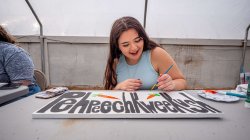
A month ago, with fields on the Munsee Three Sisters Medicinal Farm empty and snow-covered, a group of Montclair State University students and their professors began the work of getting the farm ready for spring. Hand painting garden signs, they joined efforts to advance Indigenous food sovereignty, and – in writing on those signs “pehpeechkweekush” for “carrot” and other crops in the Munsee language – they were also planting seeds to help revive a Native American language.
“It’s definitely a great place to start, but hopefully it’s not where we stop,” says Farrah Fornarotto, a junior majoring in Anthropology, with minors in Archaeology and the new Native American and Indigenous Studies. “There’s a lot to tackle.”
The challenges date back decades. Munsee Three Sisters Farm provides traditional food for the Turtle Clan of the Ramapough Lunaape (Lenape) Nation, a tribe that can no longer safely farm its own land in Upper Ringwood, New Jersey. Environmental and health issues caused by industrial dumping have led to a generational decline in the Turtle Clan members’ ability to practice their culture, including the Munsee language, which is at risk of becoming as dormant as the winter fields.
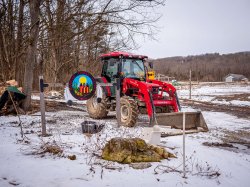
A key aspect of Montclair’s contributions are organizing the tribe’s records and documents related to the industrial dumping on ancestral land. Students are at work to help gather the scientific evidence documented at the Superfund site, the health impact and oral histories from eyewitnesses, and with University resources, creating a single, digitally accessible repository for future researchers and the tribal members who continue to fight for proper cleanup of the land.
More than 300 pages of newspaper articles detailing the dumping of toxic paint sludge from a Ford Motor Co. factory have been indexed by students. “My students are going through and creating a table of contents identifying the names [of key players], the toxic chemicals listed in reports, physical sites that are listed, agencies that are listed, and creating a searchable tool for that whole collection of news articles,” says Mark Clatterbuck, associate professor of Religion and co-director of the Native American and Indigenous Studies program.
Montclair students taking part in the class projects say they share a commitment for helping Indigenous communities. Jala Best, a senior Psychology major, says her drive comes from her experiences as an Afro-Indigenous woman.
“Oftentimes the issues of Native communities are ignored or Native people are spoken about in the past tense, like we are not still living, breathing, surviving and fighting for justice …. You can’t even conceptualize that there are atrocities happening today because you believe that it’s a thing of the past,” Best says.

Montclair has initiated a field-based partnership with Turtle Clan Chief Vincent Mann of the Ramapough Lunaape Nation. The University support includes students working directly with the tribe on food sovereignty, the language revitalization effort and ongoing environmental concerns as part of Montclair’s new minor in Native American and Indigenous Studies.
“The issues and the challenges of the Turtle Clan, they’re huge, they’re varied and there’s no shortage of them,” says Clatterbuck.
The program is closely tied to the University’s Land Acknowledgement Statement. Clatterbuck, along with History Professor Elspeth Martini and Anthropology Professor Chris Matthews consulted with New Jersey’s three state-recognized tribal nations – the Ramapough Lenape, Nanticoke Lenni-Lenape and Powhatan Renape – in drafting the statement, and also considered how it could represent a commitment from Montclair to working with and for their communities.
“It’s not just about making some sort of historical reference. It’s really about saying, ‘What is our responsibility to those communities?’” Clatterbuck says.
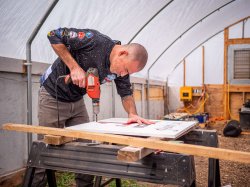
The program is intentionally community-engaged, hands-on and focused on problem-solving, including finding creative ways to support community-driven language revitalization and environmental recovery. “The Ramapough understand that part of their healing and survival is really dependent on recovering key aspects of their cultural ways,” Clatterbuck says. “Language is on par with restoring foodways and their access to clean water, land and air.”
Munsee language expert, Nikole Pecore, a member of the Stockbridge-Munsee Nation in Wisconsin, has guided Montclair students studying Linguistic Anthropology in building a digital repository of instructional materials that will be used to train new Munsee teachers and support community learners.
“We’re looking at language as a key to culture, to bringing back Munsee speaking cultures, as well as other Lenape languages belonging to original peoples in the state of New Jersey,” says Associate Anthropology Professor Maisa Taha.
Work on the farm also includes students preparing the fields and helping deliver the organic, healthy, medicinal healing crops to the community. “It’s doing the nitty-gritty work with local communities and following their lead,” Clatterbuck says.
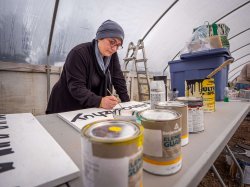
“It might be challenging to figure out how all of these different pieces fit together. But the fact of the matter is they are all intimately connected,” Taha says. “You can’t have language without culture. You can’t have culture without tribal sovereignty. You can’t have tribal sovereignty without environmental justice. What we’re bringing to our students and frankly, to ourselves as well, is this huge opportunity to work with our tribal partners in trying to understand those connections and come up with reasonable, impactful solutions that will serve them for years to come.”
Clatterbuck adds, “We’re all passionate about this on a personal level, and we see this as a matter of justice and addressing – you hear the buzzword ‘decolonization’ thrown around a lot – but as far as I’m concerned, this is what that work looks like. It’s messy, and it’s trial and error, and we’re figuring all this out as we go. But that is the work.”
Photo Gallery
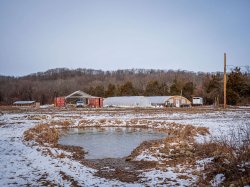
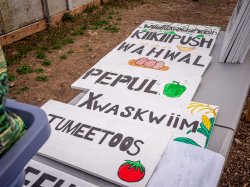
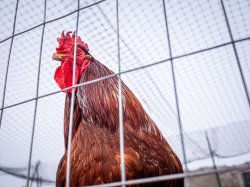
Story by Staff Writer Marilyn Joyce Lehren. Photos by John J. LaRosa.
You may also like:
